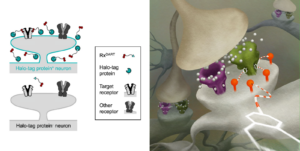
Copyright: Nature
DART.2: bidirectional synaptic pharmacology with thousandfold cellular specificity
Published in Nature Methods.
Authors
Brenda C. Shields, Haidun Yan, Shaun S. X. Lim, Sasha C. V. Burwell, Celine M. Cammarata, Elizabeth A. Fleming, S. Aryana Yousefzadeh, Victoria Z. Goldenshtein, Elizabeth W. Kahuno, Purav P. Vagadia, Marie H. Loughran, Lei Zhiquan, Mark E. McDonnell, Miranda L. Scalabrino, Mishek Thapa, Tammy M. Hawley, Greg D. Field, Court Hull, Gary E. Schiltz, Lindsey L. Glickfeld, Allen B. Reitz & Michael R. Tadross
Paper presented by Dr. Rajtarun Madangopal and selected by the NIDA TDI Paper of the Month Committee.
Publication Brief Description
DART.2 advances the original DART.1 technology, which enabled cell-specific drug targeting by tethering drugs to the HaloTag protein, to allow precise investigation of how specific proteins in defined cell types and circuits drive behavior. With up to 3,000-fold enhanced targeting precision, DART.2 allows selective delivery of even potent drugs, such as GABA antagonists, to specific neurons while minimizing off-target effects. It is compatible with brain-wide drug delivery via the lateral ventricle, removing the need for localized infusions, and incorporates fluorescent tracers for real-time visualization and quantification of drug capture, ensuring precise dose control. Uniquely, DART.2 introduces bidirectional modulation, allowing activation or inhibition of neurotransmitter pathways within the same cell populations. This expanded DART.2 toolbox enables intersectional precision—targeting genetically defined postsynaptic cells alongside neurotransmitter-defined presynaptic partners. Future refinements will aim to address challenges in systemic delivery across the blood-brain barrier, improve reversibility, and broaden compatibility with various receptor types, furthering potential for finely tuned studies of the neural dynamics underlying behavior.
DART.2: bidirectional synaptic pharmacology with thousandfold cellular specificity Journal Article
In: Nat Methods, vol. 21, no. 7, pp. 1288–1297, 2024, ISSN: 1548-7105.
